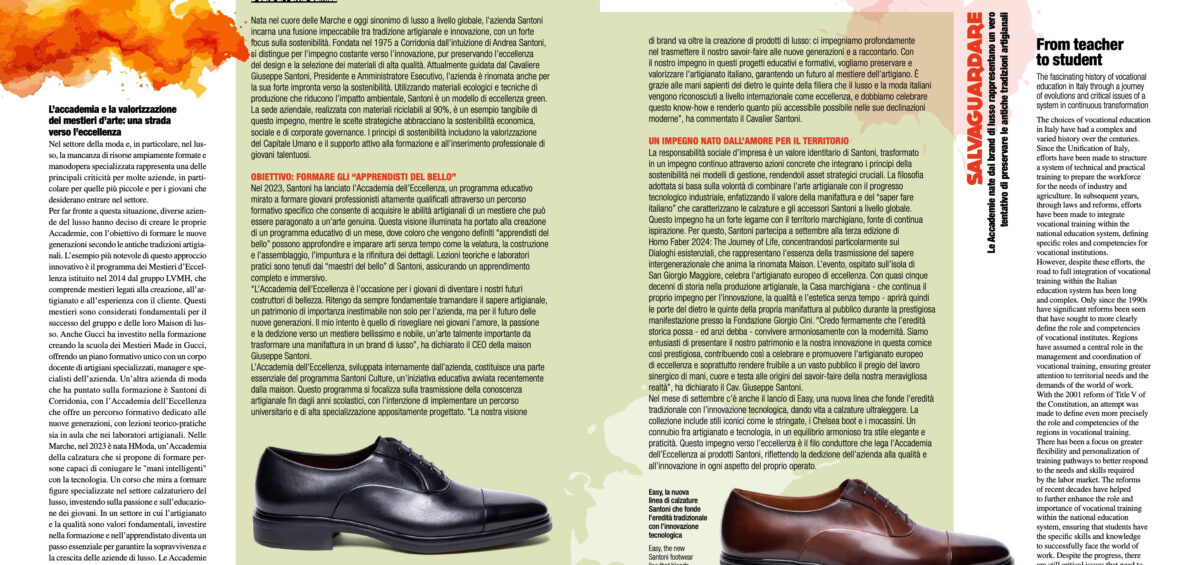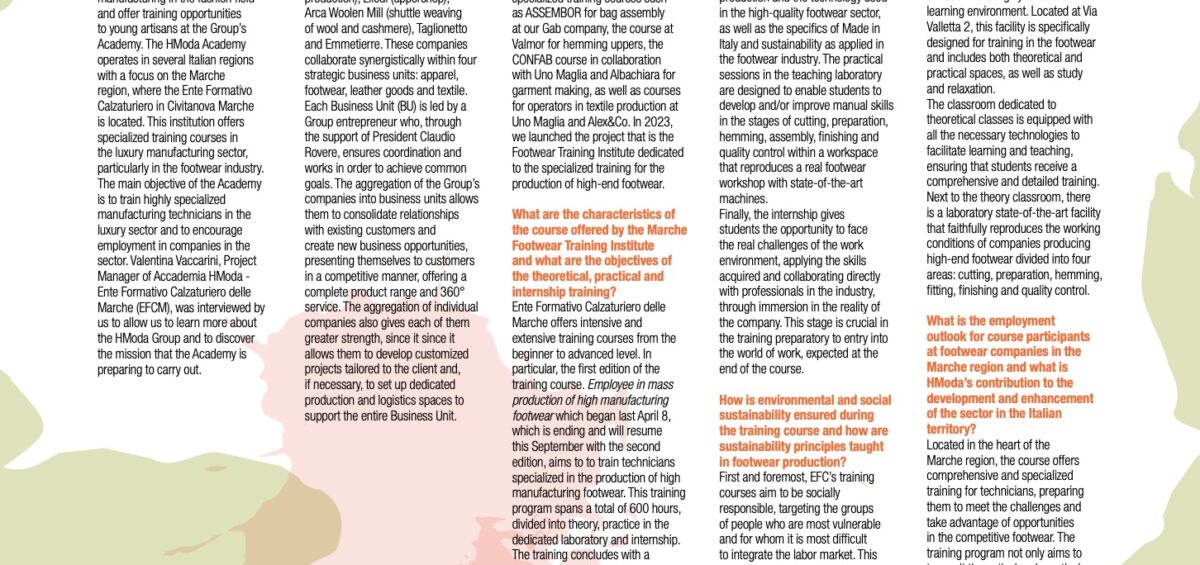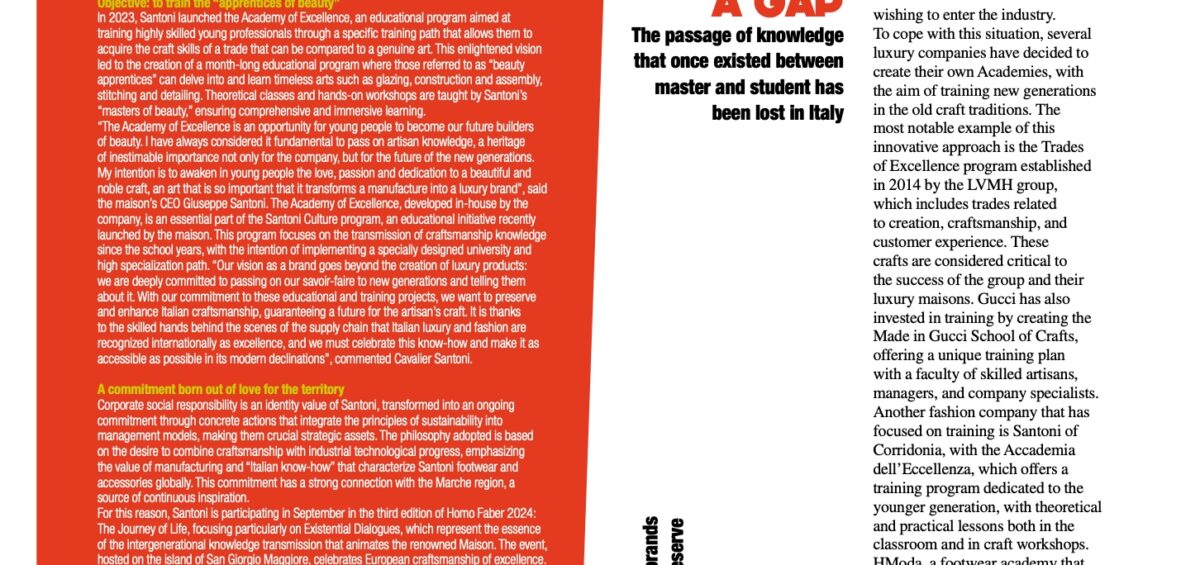Dal Maestro all’Allievo
Tech Art Shoes - settembre 2024
Dal Maestro all’Allievo
L’istruzione professionale in Italia: storia, evoluzione e criticità – Le scelte dell’istruzione professionale in Italia hanno avuto una storia complessa e variegata nel corso dei secoli. Fin dall’Unità d’Italia si è cercato di strutturare un sistema di formazione tecnica e pratica per preparare la manodopera alle esigenze dell’industria e dell’agricoltura equivalente al sapere che avveniva tramandato in passato dal maestro all’allievo. Negli anni successivi, attraverso leggi e riforme, si è cercato di integrare la formazione professionale all’interno del sistema scolastico nazionale, definendo ruoli e competenze specifiche per gli istituti professionali.
Tuttavia, nonostante gli sforzi, la strada per una piena integrazione della formazione professionale all’interno del sistema educativo italiano è stata lunga e complessa. Solo a partire dagli anni ’90 del secolo scorso si sono viste riforme significative che hanno cercato di definire in modo più chiaro il ruolo e le competenze degli istituti professionali. Le Regioni hanno assunto un ruolo centrale nella gestione e nel coordinamento della formazione professionale, garantendo una maggiore attenzione alle esigenze territoriali e alle richieste del mondo del lavoro.
Con la riforma del titolo V della Costituzione del 2001, si è cercato di definire in modo ancora più preciso il ruolo e le competenze delle Regioni in materia di formazione professionale. Si è puntato a una maggiore flessibilità e personalizzazione dei percorsi formativi, per rispondere meglio alle esigenze e alle competenze richieste dal mercato del lavoro. Le riforme degli ultimi decenni hanno contribuito a valorizzare ulteriormente il ruolo e l’importanza della formazione professionale all’interno del sistema educativo nazionale, garantendo agli studenti competenze e conoscenze specifiche per affrontare con successo il mondo del lavoro. Nonostante i progressi, ci sono ancora criticità da affrontare per rendere l’istruzione professionale efficace e adatta alle esigenze del mercato del lavoro. Nel contesto statale, gli istituti professionali offrono una formazione specializzata e rivolta alle capacità pratiche, con stage o tirocinio previsti nell’ultimo anno. L’attuale riforma prevede due macrosettori e sei indirizzi, ma mancano scuole statali che insegnano gli antichi mestieri dell’artigiano. In un Paese con forti tradizioni come l’Italia, manca e si è perso il passaggio professionale e l’insegnamento sostanziale che esisteva un tempo tra il maestro d’arte e l’allievo.
L’accademia e la valorizzazione dei mestieri d’arte: una strada verso l’eccellenza
Nel settore della moda e in particolare nel lusso, la mancanza di risorse ampiamente formate e manodopera specializzata rappresenta una delle principali criticità per molte aziende, in particolare per quelle più piccole e per i giovani che desiderano entrare nel settore.
Per far fronte a questa situazione, diverse aziende del lusso hanno deciso di creare le proprie Accademie, con l’obiettivo di formare le nuove generazioni secondo le antiche tradizioni artigianali. L’esempio più notevole di questo approccio innovativo è il programma dei Mestieri d’Eccellenza istituito nel 2014 dal gruppo LVMH, che comprende mestieri legati alla creazione, all’artigianato e all’esperienza con il cliente. Questi mestieri sono considerati fondamentali per il successo del gruppo e delle loro Maison di lusso. Anche Gucci ha investito nella formazione creando la scuola dei Mestieri Made in Gucci, offrendo un piano formativo unico con un corpo docente di artigiani specializzati, manager e specialisti dell’azienda. Un’altra azienda di moda che ha puntato sulla formazione è Santoni di Corridonia, con l’Accademia dell’Eccellenza che offre un percorso formativo dedicato alle nuove generazioni, con lezioni teorico-pratiche sia in aula che nei laboratori artigianali. Nelle Marche, nel 2023 è nata HModa, un’Accademia della calzatura che si propone di formare persone capaci di coniugare le ‘mani intelligenti’ con la tecnologia. Un corso che mira a formare figure specializzate nel settore calzaturiero del lusso, investendo sulla passione e sull’educazione dei giovani.
In un settore in cui l’artigianato e la qualità sono valori fondamentali, investire nella formazione e nell’apprendistato diventa un passo essenziale per garantire la sopravvivenza e la crescita delle aziende di lusso. Le Accademie nate dai brand di lusso rappresentano un vero tentativo di preservare le antiche tradizioni artigianali e di assicurare un futuro di eccellenza per il settore della moda e del lusso.
Hmoda: un’Accademia per formare gli artigiani del lusso del futuro
HModa è un ambizioso progetto imprenditoriale che si propone di rappresentare un Polo del lusso Made in Italy, composto da prestigiose aziende manifatturiere italiane nel settore della moda. Queste aziende, che operano sinergicamente per offrire prodotti di alta qualità nel settore del lusso, rappresentano il meglio della produzione italiana nel campo della moda e offrono opportunità di formazione a giovani artigiani presso l’Accademia del gruppo. L’Accademia HModa, opera in diverse regioni italiane con particolare attenzione alle Marche, dove si trova l’Ente Formativo Calzaturiero di Civitanova Marche. Questo ente offre percorsi di formazione specializzati nel settore della manifattura del lusso, in particolare nel settore calzaturiero. L’obiettivo principale dell’Accademia è quello di formare tecnici manifatturieri altamente specializzati nel settore del lusso e di favorire l’occupazione nelle aziende del settore. Valentina Vaccarini, project manager di Accademia HModa – Ente Formativo Calzaturiero delle Marche (EFCM), è stata intervistata da noi per permetterci di approfondire la conoscenza del Gruppo HModa e di scoprire la mission che l’Accademia si prepara a portare avanti.
- Chi sono le aziende che fanno parte del gruppo Hmoda e quali sono le Business Unit strategiche in cui collaborano sinergicamente?
HModa è un progetto industriale promosso da Hind Spa che coinvolge 17 società partecipate, tra cui Uno Maglia (lavorazioni in jersey), Alex&Co. (capi di abbigliamento in pelle), RBS (capispalla), Albachiara (abbigliamento leggero donna), GAB (pelletteria), Project (denim), Valmor e Dema (calzature), Famar (abbigliamento uomo donna), Rilievi e PuntoArt (embellishment e ricamo), Seriscreen (serigrafia e stampa su pelle e tessuti) , Beste (produzione tessuti e abbigliamento), Elledi (tomaificio), Lanificio Arca (tessitura a navetta di lana e cashmere), Taglionetto ed Emmetierre. Queste aziende collaborano sinergicamente all’interno di quattro Business Unit strategiche: abbigliamento, calzatura, pelletteria e tessuto. Ogni Business Unit (BU) è guidata da un imprenditore del Gruppo il quale, attraverso il supporto del Presidente Claudio Rovere, garantisce il coordinamento e opera al fine di raggiungere obiettivi comuni. L’aggregazione delle aziende del Gruppo in business units permette loro di consolidare le relazioni con i clienti esistenti e creare nuove opportunità di business, proponendosi al cliente in maniera competitiva, offrendo un ventaglio prodotti completo e un servizio a 360°.
L’aggregazione delle singole aziende conferisce inoltre maggior forza ad ognuna di esse dal momento che permette loro di sviluppare progetti personalizzati su misura del cliente e, se necessario, predisporre degli spazi produttivi e logistici dedicati a supporto dell’intera Business Unit. La riorganizzazione delle aziende del Gruppo HModa in Business Units si pone quindi come obiettivi il miglioramento della produttività, la sostenibilità e la soddisfazione dei clienti, garantendo al contempo una crescita stabile e sostenibile della BU e delle aziende del gruppo.
- Qual è il ruolo dell’Accademia all’interno del progetto Hmoda e quali sono i percorsi formativi offerti, in particolare nel settore calzaturiero?
L’Accademia HModa gioca un ruolo cruciale nel progetto HModa, essendo stata fondata con l’obiettivo di trasmettere il know-how delle nostre aziende alle giovani generazioni di artigiani. Offriamo percorsi formativi specializzati come ASSEMBOR per l’assemblaggio di borse presso la nostra azienda Gab, il corso presso Valmor per l’orlatura delle tomaie, il corso CONFAB in collaborazione con Uno Maglia e Albachiara per la confezione di abbigliamento, oltre a corsi per operatori nella produzione tessile presso Uno Maglia e Alex&Co. Nel 2023, abbiamo lanciato il progetto che è l’Ente Formativo Calzaturiero dedicato alla formazione specialistica per la produzione di calzature di alta gamma.
- Quali sono le caratteristiche del corso offerto dall’Ente Formativo Calzaturiero delle Marche e quali sono gli obiettivi della formazione teorica, pratica e di stage?
L’Ente Formativo Calzaturiero delle Marche offre corsi di formazione intensivi ed estensivi dal livello principiante ad avanzato. In particolare, la prima edizione del percorso formativo “Addetto alla produzione in serie di calzature di alta manifattura” iniziata lo scorso 8 aprileche sta volgendo a termine e che riprenderà questo settembre con la seconda edizione, mira a formare tecnici specializzati nella produzione di calzature di alta manifattura. Questo programma formativo si estende per un totale di 600 ore, articolate in teoria, pratica nel laboratorio dedicato e stage. La formazione si conclude con una prova teorico-pratica necessaria all’ottenimento dell’Attestato di Qualifica (livello EQF3) di Addetto alla Produzione in Serie di Calzature.
La suddivisione del tempo di formazione è progettata per garantire un’applicazione pratica intensiva delle competenze acquisite. L’obiettivo principale del corso è preparare gli studenti a integrarsi rapidamente nel mondo del lavoro all’interno delle aziende del settore calzaturiero. A conferma di ciò, il programma si propone di assicurare l’assunzione di almeno il 51% dei partecipanti presso le numerose aziende calzaturiere presenti nel territorio marchigiano.
La formazione teorica fornisce le basi fondamentali necessarie per comprendere i processi produttivi e la tecnologia utilizzata nel settore delle calzature di alta qualità nonché le specificità del Made in Italy e della sostenibilità applicati nel settore della calzatura. Le sessioni pratiche nel laboratorio didattico sono progettate per permettere agli studenti di sviluppare e/o migliorare le competenze manuali nelle fasi di: taglio, preparazione, orlatura, montaggio, finissaggio e controllo qualità all’interno di uno spazio di lavoro che riproduce un vero e proprio laboratorio calzaturiero con macchine di ultima generazione. Infine, lo stage offre agli studenti l’opportunità affrontare le sfide reali dell’ambiente lavorativo applicando le competenze acquisite e collaborando direttamente con professionisti del settore, attraverso l’immersione nella realtà dell’azienda. Questa fase è cruciale nel percorso formativo propedeutico all’ingresso nel mondo del lavoro previsto al termine del corso.
- In che modo viene garantita la sostenibilità ambientale e sociale durante il corso di formazione e come vengono insegnati i principi della sostenibilità nella produzione delle calzature?
Innanzitutto, i percorsi formativi dell’EFC mirano ad essere socialmente responsabili, rivolgendosi ai gruppi di persone più vulnerabili e per i quali è più difficile integrare il mercato del lavoro. Questo impegno si traduce in azioni concrete e mirate condotte in parnership con i centri per l’impiego del territorio. Inoltre, tutte le scarpe prodotte durante il corso sono donate alla CARITAS della regione Marche. Questo gesto non è solo un atto di beneficenza, ma rappresenta anche un modo per sensibilizzare i nostri studenti sull’importanza del dare e del contribuire al benessere della comunità. La donazione delle scarpe è un simbolo tangibile del nostro impegno a favore della responsabilità sociale e della solidarietà.
Durante il corso, insegniamo ai nostri studenti l’importanza dei materiali utilizzati nella produzione delle scarpe, l’importanza della loro provenienza e la necessità di comprendere la filiera produttiva nell’industria delle scarpe di lusso e il suo impatto in termini di ESG. Le materie prime utilizzate durante i corsi sono inoltre provenienti da scarti di lavorazioni di pelle e fodere.
- Qual è il ruolo della struttura dedicata al corso a Civitanova Marche e quali sono le attrezzature disponibili per simulare le lavorazioni proprie delle aziende calzaturiere di alta gamma?
La struttura dedicata al corso a Civitanova Marche gioca un ruolo fondamentale nell’offrire agli studenti un ambiente di apprendimento moderno e altamente funzionale. Situata in Via Valletta 2, questa struttura è specificamente progettata per la formazione nel settore calzaturiero e comprende sia spazi teorici che pratici che di studio e relax. L’aula dedicata alle lezioni teoriche è attrezzata con tutte le tecnologie necessarie per facilitare l’apprendimento e l’insegnamento, garantendo che gli studenti ricevano una formazione completa e dettagliata. Accanto all’aula teorica, vi è un laboratorio all’avanguardia che riproduce fedelmente le condizioni di lavoro delle aziende produttrici di calzature di alta gamma suddiviso in quattro aree: taglio, preparazione, orlatura, montaggio, finissaggio e controllo qualità.
- Qual è la prospettiva occupazionale per i partecipanti al corso presso le aziende calzaturiere presenti sul territorio marchigiano e qual è il contributo di Hmoda allo sviluppo e alla valorizzazione del settore nel territorio italiano?
Situato nel cuore delle Marche, il corso offre una formazione completa e specializzata per tecnici, preparandoli ad affrontare le sfide e sfruttare le opportunità nel competitivo mercato calzaturiero. Il programma formativo non solo mira a trasmettere conoscenze teoriche e pratiche, ma ha anche l’obiettivo di favorire l’inserimento professionale degli studenti. Grazie alla solida base industriale della regione marchigiana, nota per la sua tradizione artigianale e innovazione tecnologica, i partecipanti hanno accesso a un panorama ricco di opportunità di lavoro. Le numerose aziende del settore, conosciute per la qualità e il prestigio dei loro prodotti “made in Italy”, rappresentano un terreno fertile per l’avvio di una carriera di successo nel campo della calzatura. HModa si impegna attivamente nell’inserimento lavorativo degli studenti. Il fatto che almeno il 51% dei partecipanti venga assunto presso le aziende del territorio evidenzia l’efficacia e il valore del percorso formativo offerto dall’EFC.









